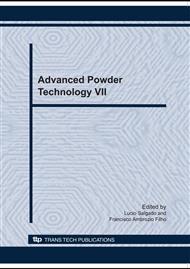[1]
J.J. Reilly and R.H. Wiswall Jr.: Inorg. Chem. Vol. 13 (1) (1974), p.218.
Google Scholar
[2]
A. Sarkar and R. Banerjee: Int. J. Hydrogen Energy Vol. 30 (2005), p.867.
Google Scholar
[3]
K. Aoki, H. Aoyagi, A. Memezawa and T. Masumoto: J. Alloys Comp. Vol. 203 (1994), p. L7-L9.
DOI: 10.1016/0925-8388(94)90704-8
Google Scholar
[4]
H. Aoyagi, K. Aoki and T. Masumoto: J. Alloys Comp. Vol. 231 (1-2) (1995), p.804.
Google Scholar
[5]
C.B. Jung, J.H. Kim and K.S. Lee: Nanostruct. Mater. Vol. 8 (8) (1997), p.1093.
Google Scholar
[6]
S. Morris, S.B. Dodd, P.J. Hall, A.J. Mackinnon and L.E.A. Berlouis: J. Alloys Comp. Vols. 293-295 (20) (1999), p.458.
Google Scholar
[7]
M. Bououdina, D. Fruchart, S. Jacquet, L. Pontonnier and J.L. Soubeyroux: Int. J. Hydrogen Energy Vol. 24 (9) (1999), p.885.
Google Scholar
[8]
C. -H. Chiang, Z. -H. Chin and T. -P. Perng: J. Alloys Comp. Vol. 307 (2000), p.259.
Google Scholar
[9]
E. Jankowska, M. Makowiecka and M. Jurczyk: J. Alloys Comp. Vols. 404–406 (2005), p.691.
Google Scholar
[10]
I. López-Báez , F.J. Espinoza-Beltrán and G. Barreiro-Rodríguez: Rev Mex. Fís. Vol. 52, (3) (2006), p.278.
Google Scholar
[11]
H. Hotta, M. Abe, T. Kuji, and H. Ushida: J. Alloys Comp. Vol. 439 (1)-22007, p.221.
Google Scholar
[12]
M. Abe and T. Kuji: J. Alloys Comp. Vols. 446–447 (2007), p.200.
Google Scholar
[13]
B. -L. Chu, S. -M. Lee, and T. -P. Perng: Int. J. Hydrogen Energy Vol. 16 (6) (1991), p.413.
Google Scholar
[14]
J. Eckert, L. Schultz and K. Urban: J. Non-Cryst. Solids Vol. 127 (1991), p.90.
Google Scholar
[15]
L. Zaluski, P. Tessier, D. H. Ryan, C. B. Doner, A. Zaluska, J.O. Ström-Olsen, M.L. Trudeau and R. Schulz: J. Mater. Res., vol. 8 (12) (1993), p.3059.
DOI: 10.1557/jmr.1993.3059
Google Scholar
[16]
A.A. Novakova, O.V. Agladze, S.V. Sveshnikov and B.P. Tarasov: Nanostruct. Mater., Vol. 10 (3) (1998), p.365.
Google Scholar
[17]
A. Szajek, M. Jurczyk and E. Jankowska: J. Alloys Comp. Vol. 348 (1-2) (2003), p.285.
Google Scholar
[18]
M. Jurczyk, E. Jankowska, M. Makowiecka and I. Wieczorek: J. Alloys Comp. Vol. 354 (2003), p. L1.
Google Scholar
[19]
F. Delogu and G. Cocco: J. Alloys Comp., Vol. 352 (2003), p.92.
Google Scholar
[20]
T. Saito: J. Alloys Comp. Vol. 364 (2004), p.113.
Google Scholar
[21]
S. Bouaricha, J. P. Dodelet, D. Guay, J. Huot and R. Schulz: Activation characteristics of graphite modified hydrogen absorbing materials, Vol. 325 (2001), p.245.
DOI: 10.1016/s0925-8388(01)01390-1
Google Scholar
[22]
M. J. Choi, H. S. Hong and K. S. Lee: J. Alloys Comp., vol. 358 (1-2) (2003), p.306.
Google Scholar
[23]
L. Lü and M. O. Lai: Mechanical Alloying, First Edition (Kluwer Academic Publishers, Boston, 1998).
Google Scholar
[24]
C. Suryanarayana: Progr. Mater. Sci. Vol. 46 (2001), p.1.
Google Scholar


